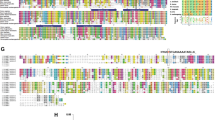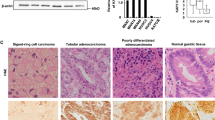Abstract
Signet-ring cell carcinoma is classified in poorly differentiated adenocarcinoma with an aggressive nature and a poor prognosis. We have shown that the activation of PI 3-kinase in highly differentiated adenocarcinomas induces loss of cell–cell contact and formation of vacuoles, giving phenotypes similar to those of signet-ring cell lines. SB203580, a potent p38 MAP kinase inhibitor, blocked this transition, and expression of an active form of MKK6 (MKK6DA), an activator of p38 MAP kinase, gave effects similar to those induced by expression of the active form of PI 3-kinase (BD110), although formation of large vacuoles was not induced. Activation of MKK3, another activator of p38 MAP kinase, was activated in native signet-ring carcinoma cell lines. Anchorage-independent growth of signet-ring cell lines was inhibited by LY294002 or SB203580. These results suggest that p38 MAP kinase is functioning downstream of PI 3-kinase in signaling of the malignant phenotype. Secretion of mucins was enhanced in BD110-expressing cells, but not in MKK6DA-expressing cells, suggesting that secretion of mucins is independent of the MKK6-p38 MAP kinase cascade. Thus, there may be at least two pathways, p38 MAP kinase-dependent and -independent, which are involved in regulation of cell–cell contact and the protein secretion system, respectively.
This is a preview of subscription content, access via your institution
Access options
Subscribe to this journal
Receive 50 print issues and online access
$259.00 per year
only $5.18 per issue
Buy this article
- Purchase on Springer Link
- Instant access to full article PDF
Prices may be subject to local taxes which are calculated during checkout






Similar content being viewed by others
References
Akiyama S, Amo H, Watanabe T, Matsuyama M, Sakamoto J, Imaizumi M, Ichihashi H, Kondo T and Takagi H . (1988). Jpn. J. Surg., 18, 438–446.
Braga V . (2000). Exp. Cell. Res., 261, 83–90.
Cassimeris L . (2002). Curr. Opin. Cell. Biol., 14, 18–24.
Coso OA, Chiariello M, Yu JC, Teramoto H, Crespo P, Xu N, Miki T and Gutkind JS . (1995). Cell, 81, 1137–1146.
Desprez PY, Lin CQ, Thomasset N, Sympson CJ, Bissell MJ and Campisi J . (1998). Mol. Cell. Biol., 18, 4577–4588.
Duane GB and Kanter MH . (1985). Acta Cytol., 29, 211–218.
Fronsdal K, Engedal N and Saatcioglu F . (2000). Prostate, 43, 111–117.
Gavet O, Ozon S, Manceau V, Lawler S, Curmi P and Sobel A . (1998). J. Cell. Sci., 111, 3333–3346.
Gimmi CD, Morrison BW, Mainprice BA, Gribben JG, Boussiotis VA, Freeman GJ, Park SY, Watanabe M, Gong J, Hayes DF, Kufe DW and Nadler LM . (1996). Nat. Med., 2, 1367–1370.
Guay J, Lambert H, Gingras-Breton G, Lavoie JN, Huot J and Landry J . (1997). J. Cell. Sci., 110, 357–368.
Hilkens J, Wesseling J, Vos HL, Storm J, Boer B, van der Valk SW and Maas MC . (1995). Biochem. Soc. Trans., 23, 822–826.
Jamora C and Fuchs E . (2002). Nat. Cell. Biol., 4, E101–E108.
Kameda H, Risinger JI, Han BB, Baek SJ, Barrett JC, Abe T, Takeuchi T, Glasgow WC and Eling TE . (2001). Mol. Cell. Biol., 21, 6895–6905.
Kanegae Y, Lee G, Deguchi Y, Sato Y, Tanaka M, Nakai M, Sasaki T, Sugano S and Saito I . (1995). Nucleic Acid Res., 23, 3816–3821.
Kita Y, Kimura KD, Kobayashi M, Ihara S, Kaibuchi K, Kuroda S, Ui M, Iba H, Konishi H, Kikkawa U, Nagata S and Fukui Y . (1998). J. Cell. Sci., 111, 907–915.
Kobayashi M, Iwamatsu A, Shinohara-Kanda A, Ihara S and Fukui Y . (2003). Oncogene, 6, 1294–1301.
Kobayashi M, Nagata S, Iwasaki T, Yanagihara K, Saitoh I, Karouji Y, Ihara S and Fukui Y . (1999). Proc. Natl. Acad. Sci. USA, 96, 4874–4879.
Kufe D, Inghirami G, Abe M, Hayes D, Justi-Wheeler H and Schlom J . (1984). Hybridoma, 3, 223–232.
Kuroda S, Fukata M, Kobayashi K, Nakafuku M, Nomura N, Iwamatsu A and Kaibuchi K . (1996). J. Biol. Chem., 271, 23363–23367.
Laffargue M, Raynal P, Yart A, Peres C, Wetzker R, Roche S, Payrastre B and Chap H . (1999). J. Biol. Chem., 274, 32835–32841.
Landry J and Huot J . (1995). Biochem. Cell. Biol., 73, 703–707.
Maeno Y, Moroi S, Nagashima H, Noda T, Shiozaki H, Monden M, Tsukita S and Nagafuchi A . (1999). Am. J. Pathol., 154, 1323–1328.
Moriguchi T, Kuroyanagi N, Yamaguchi K, Gotoh Y, Irie K, Kano T, Shirakabe K, Muro Y, Shibuya H, Matsumoto K, Nishida E and Hagiwara M . (1996). J. Biol. Chem., 271, 13675–13679.
Oda T, Kanai Y, Oyama T, Yoshiura K, Shimoyama Y, Birchmeier W, Sugimura T and Hirohashi S . (1994). Proc. Natl. Acad. Sci. USA, 91, 1858–1862.
Parker CG, Hunt J, Diener K, McGinley M, Soriano B, Keesler GA, Bray J, Yao Z, Wang XS, Kohno T and Lichenstein HS . (1998). Biochem. Biophys. Res. Commun., 249, 791–796.
Raingeaud J, Gupta S, Rogers JS, Dickens M, Han J, Ulevitch RJ and Davis RJ . (1995). J. Biol. Chem., 270, 7420–7426.
Raingeaud J, Whitmarsh AJ, Barrett T, Derijard B and Davis RJ . (1996). Mol. Cell. Biol., 16, 1247–1255.
Ridley AJ and Hall A . (1992). Cell, 70, 389–399.
Ridley AJ, Paterson HF, Johnston CL, Diekmann D and Hall A . (1992). Cell, 70, 401–410.
Sander EE, van Delft S, ten Klooster JP, Reid T, van der Kammen RA, Michiels F and Collard JG . (1998). J. Cell. Biol., 143, 1385–1398.
Tahara E . (1989). Gan To Kagaku Ryoho, 16, 2149–2155.
vom Dahl S, Dombrowski F, Schmitt M, Schliess F, Pfeifer U and Haussinger D . (2001). Biochem. J., 354, 31–36.
Yamada KM and Geiger B . (1997). Curr. Opin. Cell. Biol., 9, 76–85.
Yamamoto R, Iishi H, Tatsuta M, Nakamura H, Terada N, Komatsu K and Matsusaka T . (1990). Virchows Arch. B Cell Pathol. Incl. Mol. Pathol., 59, 26–31.
Yonezawa S and Sato E . (1997). Pathol. Int., 47, 813–830.
Zhang S, Han J, Sells MA, Chernoff J, Knaus UG, Ulevitch RJ and Bokoch GM . (1995). J. Biol. Chem., 270, 23934–23936.
Acknowledgements
This work was supported by a Grant in Aid for Cancer Research from the Ministry of Education, Science, Sports, and Culture of Japan.
Author information
Authors and Affiliations
Corresponding author
Rights and permissions
About this article
Cite this article
Xu, Q., Karouji, Y., Kobayashi, M. et al. The PI 3-kinase-Rac-p38 MAP kinase pathway is involved in the formation of signet-ring cell carcinoma. Oncogene 22, 5537–5544 (2003). https://doi.org/10.1038/sj.onc.1206796
Received:
Revised:
Accepted:
Published:
Issue Date:
DOI: https://doi.org/10.1038/sj.onc.1206796
Keywords
This article is cited by
-
Current advances in understanding the molecular profile of hereditary diffuse gastric cancer and its clinical implications
Journal of Experimental & Clinical Cancer Research (2023)
-
Gastrointestinal signet ring cell malignancy: current advancement and future prospects
Investigational New Drugs (2023)
-
IL-1B -511 Polymorphism Is Associated With Increased Risk of Certain Subtypes of Gastric Cancer in Chinese: A Case–Control Study
American Journal of Gastroenterology (2010)
-
Mek3
AfCS-Nature Molecule Pages (2009)
-
Carbonic anhydrase-related protein VIII increases invasiveness of non-small cell lung adenocarcinoma
Virchows Archiv (2006)



